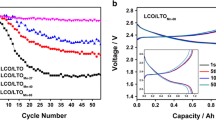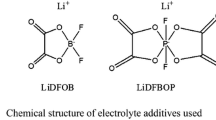Abstract
With the solid-state battery (vs. Li) application, the overlithiation mechanism of the different cathode materials is worthy to investigate. In this study, both LiMn2O4 and LiFePO4 cathode materials at different over-discharge conditions were tested using half cell (vs. Li) and anode-free systems. The cells were dismantled to study the electrode structure, surface morphology, and compositional changes. The study shows that LiMn2O4 and LiFePO4 still maintain good crystal morphology during the deep over-discharge process, showing better over-discharge resistance capability with different overlithiation mechanisms. As shown by X-ray diffraction and X-ray photoelectron spectroscopy with Ar-ion etching, the new phase, Li2Mn2O4, appears starting from 2.5 V. Until the voltage is less than 0.2 V, the framework structures of LiMn2O4 are deteriorated, and further overlithiation caused decomposition into Li2MnO2 and Li2O. LiFePO4 essentially maintains its olivine-type structure, but below 0.2 V, direct overlithiation causes decomposition into Li2O and Fe metal. Furthermore, overlithiated decomposition of LiMn2O4 and LiFePO4 occurs at very low voltages approximately 0.43 and 0.56 V, respectively. Additionally, the deep over-discharge also leads to the decay of the electrolyte structure, associated with LiF, Li2CO3 and LixPOyFz by-products. The detailed overlithiation mechanism will provide important theoretical guidance for practical applications.



















Similar content being viewed by others
References
Chombo PV, Laoonual Y (2020) A review of safety strategies of a Li-ion battery. J Power Sources 478:228649
Chen S, Gao Z, Sun T (2021) Safety challenges and safety measures of Li-ion batteries. Energy Sci Eng 00:1–26
Hauck D, Kurrat M (2018) Overdischarging lithium-ion batteries. Recycl Lithium-ion Batter 53–81. https://doi.org/10.1007/978-3-319-70572-9_4
Wang D, Zheng L, Li X, Du G, Zhang Z, Feng Y, Jia L, Dai Z (2020) Effects of overdischarge rate on thermal runaway of NCM811 Li-ion batteries. Energies 13:3885
Zhu J, Wierzbicki T, Li W (2018) A review of safety-focused mechanical modeling of commercial lithium-ion batteries. J Power Sources 378:153–168
Zhang LL, Ma YL, Cheng XQ, Du CY, Guan T, Cui YZ, Sun S, Zuo PJ, Gao YZ, Yin GP (2015) Capacity fading mechanism during long-term cycling of over-discharged LiCoO2/mesocarbon microbeads battery. J Power Sources 293:1006–1015
He H, Liu YD, Liu Q, Li ZF, Xu F, Dun C, Ren Y, Wang MX, Xie J (2013) Failure investigation of LiFePO4 cells in over-discharge conditions. J Electrochem Soc 160:A793–A804
Flügel M, Kasper M, Pfeifer C, Wohlfahrt-Mehrens M, Waldmann T (2021) Cu dissolution during over-discharge of Li-ion cells to 0 V: a post-mortem study. J Electrochem Soc 168:020506
Juarez-Robles D, Vyas AA, Fear C, Jeevarajan JA, Mukherjee PP (2020) Overdischarge and aging analytics of Li-ion cells. J Electrochem Soc 167:090558
Langner T, Sieber T, Acker J (2021) Studies on the deposition of copper in lithium-ion batteries during the deep discharge process. Sci Rep 11:6316
Pasta M, Armstrong D, Brown ZL, Bu J, Castell MR, Chen P, Cocks A, Corr SA, Cussen EJ, Darnbrough E, Deshpande V, Doerrer C, Dyer MS, El-Shinawi H, Fleck N, Grant P, Gregory GL, Grovenor C, Hardwick LJ, Irvine JTS, Lee HJ, Li G, Liberti E, McClelland I, Monroe C, Nellist PD, Shearing PR, Shoko E, Song W, Jolly DS, Thomas CI, Turrell SJ, Vestli M, Williams CK, Zhou Y, Bruce PG (2020) 2020 roadmap on solid-state batteries. J Phys Energy 2:032008
Chen L, Huang Y-F, Ma J, Ling H, Kang F, He Y-B (2020) Progress and perspective of all-solid-state lithium batteries with high performance at room temperature. Energy Fuels 34:13456–13472
Shu J, Shui M, Huang FT, Ren YL, Wang QC, Xu D, Hou L (2010) A new look at lithium cobalt oxide in a broad voltage range for lithium-ion batteries. J Phys Chem C 114:3323–3328
Zhang K, Ren F, Wang X, Hu E, Xu Y, Yang XQ, Li H, Chen L, Pianetta P, Mehta A, Yu X, Liu Y (2017) Finding a needle in the haystack: identification of functionally important minority phases in an operating battery. Nano Lett 17:7782–7788
Nelson Weker J, Wise AM, Lim K, Shyam B, Toney MF (2017) Operando spectroscopic microscopy of LiCoO2 cathodes outside standard operating potentials. Electrochim Acta 247:977–982
Yang Z, Ong PV, He Y, Wang L, Bowden ME, Xu W, Droubay TC, Wang C, Sushko PV, Du Y (2018) Direct visualization of Li dendrite effect on LiCoO2 cathode by in situ TEM. Small 14:e1803108
Yu L, Tian Y, Xiao X, Hou C, Xing Y, Si Y, Lu H, Zhao Y (2021) Investigation on the overlithiation mechanism of LiCoO2 cathode for lithium ion batteries. J Electrochem Soc 168(5):050516
Usubelli C, Besli MM, Kuppan S, Jiang N, Metzger M, Dinia A, Christensen J, Gorlin Y (2020) Understanding the overlithiation properties of LiNi0.6Mn0.2Co0.2O2 using electrochemistry and depth-resolved X-ray absorption spectroscopy. J Electrochem Soc 167:080514
Robert R, Novak P (2018) Switch of the charge storage mechanism of LixNi0.80Co0.15Al0.05O2 at overdischarge conditions. Chem Mater 30:1907–1911
Kumagai N, Kim J, Kadoma Y (2010) Impact of excess Li on the structural and electrochemical properties of Li1+x(NizCo1−2zMnz)1−xO2 materials for lithium-ion batteries. Electrochemistry 78(1):23–29
Benedek R, Vaughey J, Thackeray MM (2006) Theory of overlithiation reaction in LiMO2 battery electrodes. Chem Mater 18(5):1296–1302
Lee S, Oshima Y, Hosono E, Zhou H, Kim K, Chang HM, Kanno R, Takayanagi K (2013) In situ TEM observation of local phase transformation in a rechargeable LiMn2O4 nanowire battery. J Phys Chem C 117:24236–24241
Luo F, Wei C, Zhang C, Gao H, Niu J, Ma W, Peng Z, Bai Y, Zhang Z (2020) Operando X-ray diffraction analysis of the degradation mechanisms of a spinel LiMn2O4 cathode in different voltage windows. J Energy Chem 44:138–146
Erichsen T, Pfeiffer B, Roddatis V, Volkert CA (2020) Tracking the diffusion-controlled lithiation reaction of LiMn2O4 by in situ TEM. ACS Appl Energy Mater 3:5405–5414
Shu J, Shui M, Xu D, Wang DJ, Ren YL, Gao S (2012) A comparative study of overdischarge behaviors of cathode materials for lithium-ion batteries. J Solid State Electrochem 16:819–824
Daniel C, Mohanty D, Li J, Wood DL (2014) Cathode materials review. 26–43. https://doi.org/10.1063/1.4878478
Ling C, Mizuno F (2012) Capture lithium in αMnO2: insights from first principles. Chem Mater 24:3943–3951
Barsoukov E (2003) Comparison of kinetic properties of LiCoO2 and LiTi0.05Mg0.05Ni0.7Co0.2O2 by impedance spectroscopy. Solid State Ion 161:19–29
Li J, Harlow J, Stakheiko N, Zhang N, Paulsen J, Dahn J (2018) Dependence of cell failure on cut-off voltage ranges and observation of kinetic hindrance in LiNi0.8Co0.15Al0.05O2. J Electrochem Soc 165:A2682–A2695
Liu S, Su J, Zhao J, Chen X, Zhang C, Huang T, Wu J, Yu A (2018) Unraveling the capacity fading mechanisms of LiNi0.6Co0.2Mn0.2O2 at elevated temperatures. J Power Sources 393:92–98
Li J, Xing L, Wang Z, Tu W, Yang X, Lin Y, Liao Y, Xu M, Li W (2018) Insight into the capacity fading of layered lithium-rich oxides and its suppression via a film-forming electrolyte additive. RSC Adv 8:25794–25801
Tatara R, Karayaylali P, Yu Y, Zhang Y, Giordano L, Maglia F, Jung R, Schmidt JP, Lund I, Shao-Horn Y (2018) The effect of electrode-electrolyte interface on the electrochemical impedance spectra for positive electrode in Li-ion battery. J Electrochem Soc 166:A5090–A5098
Liu C-Y, Yang Y, Yao M, Fang H-T (2019) Lithium difluoro(oxalate)borate improving the zero-volt storage performance of lithium-ion batteries by offering anode SEI film tolerance to high potentials. Energy Storage Mater 18:148–154
Li S, Fu X, Liang Y, Wang S, Zhou XA, Dong H, Tuo K, Gao C, Cui X (2020) Enhanced structural stability of boron-doped layered@spinel@carbon heterostructured lithium-rich manganese-based cathode materials. ACS Sustain Chem Eng 8:9311–9324
Zhang Y, Wang Z-B, Yu F-D, Que L-F, Wang M-J, Xia Y-F, Xue Y, Wu J (2017) Studies on stability and capacity for long-life cycle performance of Li(Ni0.5Co0.2Mn0.3)O2 by Mo modification for lithium-ion battery. J Power Sources 358:1–12
Azmi R, Masoumi M, Ehrenberg H, Trouillet V, Bruns M (2018) Surface analytical characterization of LiNi0.8-yMnyCo0.2O2 (0≤y≤0.4) compounds for lithium-ion battery electrodes. Surf Interface Anal 50:1132–1137
Azmi R, Trouillet V, Strafela M, Ulrich S, Ehrenberg H, Bruns M (2018) Surface analytical approaches to reliably characterize lithium ion battery electrodes. Surf Interface Anal 50:43–51
Novikova SA, Yaroslavtsev AB (2017) Lithium deintercalation/intercalation processes in cathode materials based on lithium iron phosphate with the olivine structure. Russ Chem Bull 66(8):1336–1344
Zhang B, Wang S, Li Y, Sun P, Yang C, Wang D, Liu L (2020) Review: phase transition mechanism and supercritical hydrothermal synthesis of nano lithium iron phosphate. Ceram Int 46:27922–27939
Hsieh H-W, Wang C-H, Huang A-F, Su W-N, Hwang BJ (2021) Green chemical delithiation of lithium iron phosphate for energy storage application. Chem Eng J 418:129191
Kumar A, Srivastava PC (2019) X-ray photoelectron spectroscopy (XPS) study of Heusler alloy (Co2FeAl) interfaced with semiconductor (n-Si) structure. Mater Sci-Pol 37:116–121
Wang L, Li Y, Wu J, Liang F, Zhang K, Xu R, Wan H, Dai Y, Yao Y (2020) Synthesis mechanism and characterization of LiMn0.5Fe0.5PO4/C composite cathode material for lithium-ion batteries. J Alloy Compd 839:155653
Grosvenor AP, Kobe BA, Biesinger MC, McIntyre NS (2004) Investigation of multiplet splitting of Fe 2p XPS spectra and bonding in iron compounds. Surf Interface Anal 36:1564–1574
Zhang M, Wang T, Cao H, Cui S, Du P (2020) Self-supported Ni2P nanosheets on low-cost three-dimensional Fe foam as a novel electrocatalyst for efficient water oxidation. J Energy Chem 42:71–76
Erickson EM, Li W, Dolocan A, Manthiram A (2020) Insights into the cathode−electrolyte interphases of high-energy-density cathodes in lithium-ion batteries. ACS Appl Mater Interfaces 12:16451–16461
Yang SJ, Yao N, Xu XQ, Jiang FN, Chen X, Liu H, Yuan H, Huang JQ, Cheng XB (2021) Formation mechanism of the solid electrolyte interphase in different ester electrolytes. J Mater Chem A 1–5. https://doi.org/10.1039/d1ta02615a
Funding
This research was funded by the Beijing Municipal Education Commission (KZ201910005003) and the Collaborative Innovation Center of Henan Province for Motive Power and Key Materials.
Author information
Authors and Affiliations
Corresponding author
Ethics declarations
Conflict of interest
The authors declare no competing interests.
Additional information
Publisher’s note
Springer Nature remains neutral with regard to jurisdictional claims in published maps and institutional affiliations.
Supplementary Information
Below is the link to the electronic supplementary material.
Rights and permissions
About this article
Cite this article
Yu, L., Tian, Y., Xing, Y. et al. Unraveling the overlithiation mechanism of LiMn2O4 and LiFePO4 using lithium-metal batteries. Ionics 27, 5021–5035 (2021). https://doi.org/10.1007/s11581-021-04211-w
Received:
Revised:
Accepted:
Published:
Issue Date:
DOI: https://doi.org/10.1007/s11581-021-04211-w




